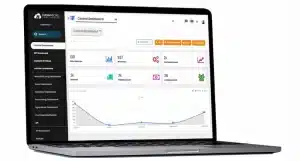In today’s competitive business world, efficient inventory management is crucial for smooth operations and customer satisfaction. A popular strategy to achieve this is Vendor Managed Inventory (VMI). But what is VMI, and how does it help businesses? VMI fosters a collaborative relationship between vendors and companies, utilizing technology to optimize inventory processes, improve order precision, and minimize rework.
This article delves into the basics of VMI and its benefits, helping businesses succeed in today’s fast-paced market.
Table of Contents
Key Takeaways
|
What is Vendor Managed Inventory?
Vendor Managed Inventory (VMI) is a supply chain strategy where the vendor is responsible for monitoring and replenishing the customer’s inventory. In this arrangement, the supplier gains access to the customer’s inventory data to decide when and how much to replenish.
This method shifts the responsibility of inventory management from the customer to the supplier, resulting in more efficient stock levels, fewer stock-outs, and a smoother replenishment process.
VMI encourages better collaboration between suppliers and customers, lowers inventory holding costs, and improves overall supply chain performance. By using centralized inventory management software, vendor inventory management gives suppliers control over inventory decisions for retailers, as seen in large companies like Amazon.
It is also referred to as managed inventory, continuous replenishment program, or supplier-assisted inventory replenishment.
How Vendor Managed Inventory Works
Matapos malaman ang kahulugan ng Vendor Managed Inventory, tiyak na tatanungin mo kung paano ito gumagana. Vendor Managed Inventory (VMI) works by integrating data from both suppliers and customers, including sales figures and inventory levels. Here’s a straightforward explanation of the process:
- The distribution partner submits a Product Activity Report to the vendor inventory management system, detailing sales, product transfers, and inventory levels.
- The vendor inventory management system processes this information and creates inventory replenishment recommendations based on predetermined targets and factors.
- The supplier reviews and gives approval for the recommendations.
- The VMI system electronically sends a purchase order (PO) to the supplier using the EDI format, while also sending a PO confirmation to the distribution partner.
- Once the distribution partner approves the PO, the supplier proceeds with shipping the order.
Implementing another software, like manufacturing inventory software, can help the vendor to integrate sales figures and inventory levels.
Benefits of Implementing Vendor Managed Inventory for Companies
You already know how Vendor Management Software mostly works. So, what about the benefits it offers? Ipinapakita namin sa ibaba ang mga benepisyo na maibibigay ng pagpapatupad ng VMI para sa mga kumpanya:
- Enables suppliers to manage downstream decisions, contributing to more efficient transportation management.
- Strengthens long-term partnerships with suppliers.
- Enhances customer experience by preventing stockouts, reducing potential frustration.
- Increases transparency by offering insight into product origin and manufacturing processes, boosting customer trust.
Although VMI provides many advantages, businesses should be mindful of potential challenges, including communication issues, cultural resistance, and unclear responsibility boundaries. By capitalizing on VMI’s benefits and tackling these obstacles, companies can enhance inventory accuracy, improve forecasting, and elevate service levels.
Read More: Top Construction Inventory Management Software
Disadvantages of Vendor Managed Inventory
Indeed, we previously explained that vendor inventory management can help improve factory productivity. However, this does not mean that vendor-managed inventory has no drawbacks. In its implementation, VMI has some drawbacks that you should be aware of.
Sa ibaba ay ipinakita namin ang mga kawalan ng VMI na dapat mong bigyang pansin:
- Limited control: In VMI, the supplier manages inventory decisions, reducing the company’s direct control over stock levels and ordering processes.
- Communication issues: Successful vendor inventory management relies on clear communication and data sharing between the company and supplier. Any disruptions can result in misalignment and inventory errors.
- Financial strain: vendor inventory management software can incur significant administrative costs, including investments in software, data analysis tools, and communication systems, potentially affecting a company’s working capital and limiting funds for other essential operations.
- Supplier dependency: Relying on the supplier for inventory management means that any inefficiencies or problems on their end, such as delayed shipments or inaccurate forecasts, can negatively affect the company’s operations.
Implement HashMicro’s VMI System for Effective and Error-Free Inventory Management
If you’re seeking dependable vendor inventory management software, HashMicro’s Inventory Management Software is an excellent choice. This robust system provides complete inventory management features, enabling businesses to easily handle thousands of items. It helps maintain ideal inventory levels, track stock transfers, and streamline stock management across multiple locations in the Philippines.
Key benefits of HashMicro’s Inventory Management System include effortless inventory tracking, optimized stock levels with low stock alerts and future demand forecasting, and real-time stock movement monitoring through an operational dashboard. Additionally, it reduces waste by prioritizing the sale of older inventory.
The software also offers features such as barcode management, stock request handling, inventory forecasting, and integrations with accounting, purchasing, CRM, and POS systems. Implementing HashMicro’s system helps companies gain greater control and efficiency in their inventory processes.
Conclusion
In summary, Vendor-Managed Inventory (VMI) is a strategy in which suppliers optimize inventory levels for distributors. Although VMI provides numerous advantages, it also brings challenges related to communication and clearly defining responsibilities.
Implementing a vendor managed inventory (VMI) system, such as the HashMicro’s inventory management system, can be incredibly useful for companies. HashMicro’s system allows for smooth inventory tracking, optimal stock levels, and effective management of stock across various locations. Mag-iskedyul ng libreng demo ngayon at tingnan kung paano makikinabang ang HashMicro sa iyong kumpanya.























